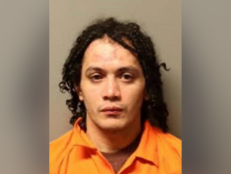5 Bizarre Facts You May Not Know About Serial Killer John Wayne Gacy
The “killer clown” continues to shock and horrify, decades after his execution.
![John Wayne Gacy [Des Plaines Police Department]](http://investigationdiscovery.sndimg.com/content/dam/images/investigationdiscovery/crimefeed/legacy/2019/03/John-Wayne-Gacy_Des-Plaines-Police-4122019.jpg.rend.hgtvcom.616.493.suffix/1552339425871.jpeg)
John Wayne Gacy [Des Plaines Police Department]
When it comes to true crime history, John Wayne Gacy stands out as an especially nightmarish serial rapist, torturer, and murderer.
Since his arrest in December 1978, the Chicago-area slayer of at least 33 boys and young men has continually sickened and fascinated the public both with the scope and the sadism of his crimes, as well as his proclivity for dressing up as a circus-styled funnyman called “Pogo the Clown.”
As a result, many facts are well known about John Wayne Gacy and his atrocities, especially among true crime aficionados.
Among such lore is the severe sexual and physical abuse Gacy suffered as a child, his early professional work in a mortuary, his local community involvement that led to a photograph with First Lady Rosalynn Carter, and how he lured young victims to his home where he tricked them into being bound, and then raped and murdered them before burying their bodies in a crawlspace.
Let’s take a look at some of the lesser-known facts about the “killer clown” and his legacy of real-life horror.
Before the murders, Gacy got arrested for molesting a teenage boy, then paid another teen to beat up the victim
In 1967, John Wayne Gacy was a married father of two, an active member of the Jaycees charitable organization, and a highly paid manager of three Kentucky Fried Chicken (KFC) franchise outlets, which prompted friends to nickname him “The Colonel”.
However, Gacy was also grappling with taboo impulses, such as when he said he was aroused by the site of naked male corpse, and the desires set off by an alleged homosexual encounter with another adult Jaycees member — desires that Gacy focused on young boys.
To attract teenagers for sex, Gacy converted his basement into a hangout where he provided alcohol and pornography. One target, 15-year-old Donald Voorhees, said Gacy got him drunk then forced him into performing oral sex.
After that, Gacy allegedly felt emboldened and regularly paid an unknown number of teen boys $50 for sex. He also blackmailed some of the teenagers to keep the abuse going.
In August 1968, Donald Voorhees told his father, a friend of Gacy’s from the Jaycees, about what had been done to him. Another 16-year-old victim went directly to the police. Gacy was arrested and indicted on one count of sodomy.
Gacy immediately denied the claims, and then paid an 18-year-old employee of his to beat up Voorhees and tell him to stay out of court. Upon promptly getting caught, Gacy admitted everything and was sentenced to 10 years in prison.
He served two years, got his high school degree, and excelled as the facility’s head cook. Gacy then got off in 1971 with time served and just 12 months of probation, according to ThoughtCo.
Robin Gecht, leader of the satanic cannibal serial killers known as "The Chicago Ripper Crew," worked for John Wayne Gacy
After being sentenced to death in 1980, John Wayne Gacy actively studied law at the Menard Correctional Center in Chester, Illinois. He continued to maintain that at least 28 of the murders had been committed by employees who had keys to his house. That claim seemed implausible until it was later revealed that Gacy had at least once hired handyman Robin Gecht to work as a subcontractor.
Gecht, it turned out, was the leader of The Chicago Ripper Crew, a four-man gang of devil-worshipping sexual sadists who raped, tortured, and cannibalized victims, often prostitutes, that they either picked up off the street or simply grabbed and forced inside the group’s van. The Ripper Crew is suspected in the disappearance of 18 area women throughout 1981 and ’82.
No criminal connection has ever been established between Gacy and Gecht, and the former’s claims of anything resembling innocence have been repeatedly disproven. Still, some observers have long wondered if Gacy had help in committing his abominations, and Gecht is a figure that naturally comes up in such speculative conversations.
Investigators are still working to solve the totality of Gacy’s crimes
Of the 33 bodies recovered from John Wayne Gacy’s property, all but five have been properly identified. Authorities are continuing to work to match names to the evidence, in order to honor the lives Gacy took and to provide closure for the loved ones of the remaining unknown victims.
In 2018, DNA testing positively identified the boy previously referred to as “Victim No. 24.” He was James “Jimmy” Haakenson, a 16-year-old from St. Paul, Minnesota, who had hopped a bus to Chicago in the summer of 1976, called his mom, and then disappeared.
Also in 2018, the National Center for Missing and Exploited Children used facial reconstruction techniques to release new images of what two more of Gacy’s unidentified victims might have looked like.
Both reconstructed faces appear to be white males, possibly between the ages of 17 and 22 years old. It’s hoped that someone will see these sketches and recognize the faces of someone who has been missing for more than four decades.
In October 2021, Cook County Sheriff’s Police identified Victim #5 found in Gacy’s crawl space on Dec. 26,1978 as Francis Wayne Alexander. According to the Sheriff's Office, Alexander would have been 21 or 22 years old at the time of his murder, which was believed to have occurred sometime between early 1976 and early 1977.
More information continues to arise among the living, as well. In May 2018, David Bolton, a 71-year-old Chicago resident publicly recalled his encounter at age 10 with an older teenager he believes was John Wayne Gacy.
The Clown and the Candyman Podcast
Two serial killers, Dean Corll and John Wayne Gacy, thousands of miles apart, brutally murdered over 60 teenage boys. The police said the murders were the work of these sole deranged killers, but for the first time we reveal that they were actually connected by a network of pedophiles which was partially financed by prominent members of American society. This is America's sordid secret.
Bolton said he met the teen at a lakeside vacation resort in Wisconsin and, during a fishing expedition, the older kid forced Bolton to kill frogs and threatened to drown him. Looking back, Bolton told The Daily Herald, “It hit me like a ton of bricks. I can’t prove it, but it was him.”
Gacy has inspired numerous books, films, and other pop culture phenomena — including food
John Wayne Gacy’s creepy clown paintings are one of the key components of the killer’s hold on the public’s interest. In Spring 2017, a Gacy portrait of Pogo the Clown was sold at a Philadelphia art auction for $7,500.
In addition, Gacy’s twisted connection to low-level show business has also made him a popular subject of films. Some of these movies are fact-based, such as the acclaimed TV-film To Catch a Killer (1992) with Brian Dennehy; Gacy (2003) with Mark Holton in the title role; and the Canadian production Dear Mr. Gacy (2010), which stars William Forsythe. In 2010, two more horror films inspired by Gacy came out; 8213 Gacy House and Dahmer vs. Gacy.
In 2021, ID released The Clown and The Candyman, a two-part documentary about Gacy and serial killer Dean Corll. In April 2022, Netflix released Conversations with a Killer: The John Wayne Gacy Tapes, which features never-before-heard audio tapes from the killer, as well as archival footage.
In 2018, a pop-up Japanese eatery called Ningu, which roughly translates as “human restaurant,” incorporated Gacy lore into its menu. Esquire reported that Ningu was the product of the art collective Chim Pom. It served recreations of the last meals consumed by notorious killers just before their executions. Among the restaurant’s selections was Gacy’s order of KFC chicken, fried shrimp, French fries, and a pound of strawberries.
At least one murderous “Gacy fan” may have copied some of the killer clown’s signature methods
In September 2017, police in Wilmer, Alabama, arrested 32-year-old Nathaniel Sebastian, a self-described “John Wayne Gacy fan” for the murder of his mother, Susan Mayo, 60.
After allegedly killing Mayo, police say, Sebastian stuffed her body in a barrel and hid it under his house, in much the same manner that Gacy hid his victims.
Mobile County Sheriff’s Office Captain Paul Burch told the press that authorities had been eyeing Sebastian since Mayo had vanished the previous June. After obtaining a search warrant, officers found Mayo’s corpse inside a 55-gallon drum beneath Sebastian’s porch.
Burch said, “Once Nathaniel Sebastian realized we were about to look under the front porch, he made a spontaneous statement that, ‘Okay, my mama’s under the front porch. Y’all got me.’”
As to how police thought to look down there, Burch said, “One thing is that [Sebastian] claims to be a big fan of John Gacy, who was a serial killer and he, in fact, kept bodies of his victims underneath his house. And whether that’s coincidental or not, that certainly gave some thought to leading us there.”
For more on John Wayne Gacy, stream The Clown and the Candyman on discovery+.










